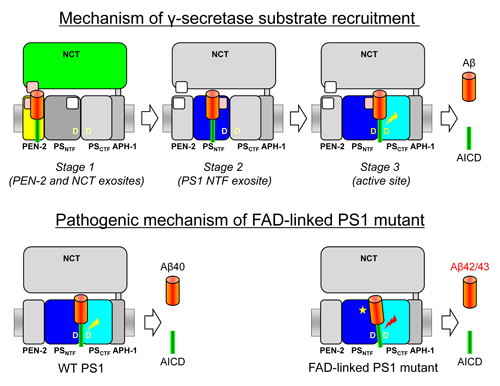Substrate recruitment of γ-secretase and mechanism of clinical presenilin mutations revealed by photoaffinity mapping
EMBO J. 2016 May 23. pii: e201694151. [Epub ahead of print]
| Authors/Editors: |
Harald Steiner |
|---|---|
| Type of Publication: | Journal Article |
A crosslinking approach reveals the substrate binding sites of the Alzheimer's disease‐associated γ‐secretase complex and provides insight into how the subunits of this pivotal intramembrane protease interact in substrate recruitment.
Highlights:
- The N‐terminal fragment of presenilin is the principal γ‐secretase substrate‐binding site.
- The non‐catalytic subunits PEN‐2 and NCT provide additional substrate‐binding sites.
- Substrate translocates stepwise from PEN‐2/NCT to the catalytic site in presenilin.
- Altered substrate binding by clinical presenilin mutants suggests a disease mechanism for familial AD.
Intramembrane proteases execute fundamental biological processes ranging from crucial signaling events to general membrane proteostasis. Despite the availability of structural information on these proteases, it remains unclear how these enzymes bind and recruit substrates, particularly for the Alzheimer's disease-associated γ-secretase. Systematically scanning amyloid precursor protein substrates containing a genetically inserted photocrosslinkable amino acid for binding to γ-secretase allowed us to identify residues contacting the protease. These were primarily found in the transmembrane cleavage domain of the substrate and were also present in the extramembranous domains. The N-terminal fragment of the catalytic subunit presenilin was determined as principal substrate-binding site. Clinical presenilin mutations altered substrate binding in the active site region, implying a pathogenic mechanism for familial Alzheimer's disease. Remarkably, PEN-2 was identified besides nicastrin as additional substrate-binding subunit. Probing proteolysis of crosslinked substrates revealed a mechanistic model of how these subunits interact to mediate a stepwise transfer of bound substrate to the catalytic site. We propose that sequential binding steps might be common for intramembrane proteases to sample and select cognate substrates for catalysis.




